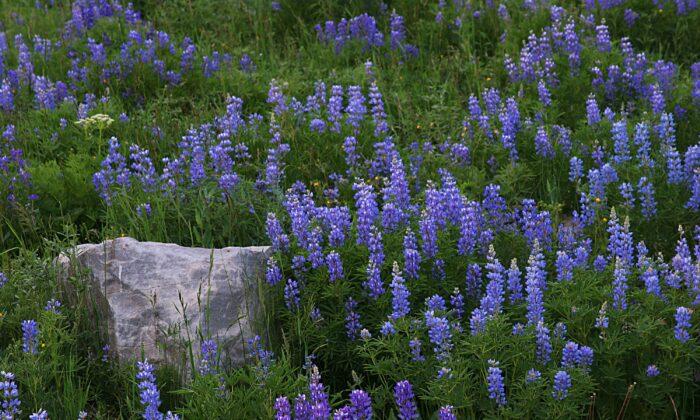Denver—With Colorado’s snowpack ranging from ample to exceptional this spring, hikers who adore wildflowers may already be envisioning days of strolling along lush landscapes of spectacular blooms under columbine-blue skies when all that snow melts.
It could well happen this summer. But because several factors affect the quality of wildflower seasons, and some of them have yet to play out, experts say it’s too soon to predict whether wildflower viewing will be good this year or great. It depends on what happens over the next few weeks.
“The mountains are probably going to have a pretty good year,” said Thomas Bates, a plant ecologist for the Arapaho and Roosevelt national forests, which encompass the northern Front Range high country. “The critical time is not now, because there’s still snow. It’s that three to six weeks after the snow melts. We have ample moisture, but it does depend on how that moisture comes off—in the timing, and the rate.”
A hot spell would speed up the rate of snowmelt, perhaps with detrimental effects. If temperatures are cool, or conditions are too wet, blooms could be delayed. Warmth with low humidity could mean some of the snowpack will evaporate without becoming liquid, a process called sublimation.
“That can eat up a lot of the moisture,” Bates said. “If you have really dry atmospheres, that’s going to prevent water from getting into the system. If it melts too fast and runs off without soaking in, that’s going to have an effect.”
In California, which has seen astonishing snowfall and rain from a persistent “atmospheric river” of moisture flowing from the Pacific Ocean—which also augmented Colorado’s above-average snowpack—“super blooms” have been reported. The California Department of Parks and Recreation posted a guide on its website directing wildflower fans to the best places for viewing from the Bay Area to southern California. Desert blooms have been reported in southern California and Arizona.
“For those types of deserts, it really is as simple as when it rains all winter, the flowers are crazy,” said Tyler Johnson, botanist for the Rocky Mountain Region of the U.S. Forest Service. “For Colorado, it’s not that straightforward, even for our deserts and dry places like grasslands and prairies. Because the vast majority of the wildflowers in Colorado grow for multiple years, there are some legacy impacts from how wet or dry previous winters and summers were that will impact how prevalent the blooms are this year.
“That’s not to say blooms won’t be good this year, they will be, it just won’t approach ‘super blooms’ until we get a few wet winters in a row.”
The timing of Colorado wildflower blooms unfolds in an opposite way from fall foliage progression. Wildflower peaks occur first in the southern part of the state and progress north. They also start at lower elevations and progress to higher locations.

“As nighttime minimum temperatures increase and plants are exposed to more sunlight during the day, an increase in soil moisture can signal to the plants to produce more flowers in hopes of producing more seeds,” Johnson said. “A super dry summer can blunt the momentum that a wet winter provides, especially for the mountains. The grasslands and foothills will be past their peak by the time summer precip becomes an issue, but a dry summer can have ramifications for next year’s blooms. Stressed plants from a dry previous summer won’t have many resources ready for next spring.”
The recent heavy rain should give Front Range gardens a major boost.
“The amount of water we had in this storm is so abundant that, if this is followed by warming, we’re going to see incredible growth in the next couple of weeks,” said Maggie Gaddis, executive director of the Colorado Native Plant Society. “But any early growth is hard to sustain without a strong monsoon later in the (summer).”
Arapaho and Roosevelt forest administrators also manage the Pawnee National Grassland, located 50 miles east of Fort Collins. Johnson said Colorado grasslands are blooming now, as are lower elevations on the Western Slope. He expects the foothills to follow in a few weeks and last until late June. Mountain wildflowers should start blooming around July 4, lasting into August. Mountain blooms could be delayed a week or two, though, depending on when the snowmelt ends.
A gorgeous Colorado canyon will be raftable for the first time since 2019 thanks to heavy snowpack
Hikers may have favorite trails for their wildflower hikes, but Johnson recommended adding ski resort trails to their lists. They, too, are located on national forest land.
“Developed ski areas usually have really good and easily accessible wildflower viewing,” Johnson said. “Winter ski runs turn into mountain meadows in the summer.”
He cautions that those runs can be steep for hiking, though.
“They feel way steeper going up on foot than they do going the other way on skis,” Johnson said. “I’m always surprised how steep even a green run is on foot.”
Copyright 2023 MediaNews Group, Inc. Visit at denverpost.com. Distributed by Tribune Content Agency, LLC.






